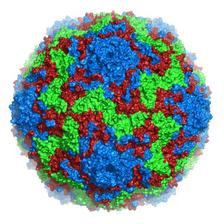Structure of the Bovine Enterovirus 2, measured at Diamond Light Source (UK).
Modern X-ray light sources like PETRA III allow scientists to determine atomic structures of very large protein molecules or even whole viruses. However, the intense X-ray radiation also causes damage to biological and organic samples within a short period of time. In fact, the lifetime of samples irradiated with X-ray beams can be substantially extended by cooling them down to low temperatures, typically minus 196 degrees. For X-ray structure determination crystalline samples are required. So far, cryocooling these crystals, such as crystallised viruses, wasn’t always possible. An international team including DESY scientists now succeeded in cryocooling very large molecular complexes to minus 196 degrees with the technique high-pressure-freezing, thus extending their lifetime in the X-ray beam.
X-ray investigations of viruses and other biological macromolecules represent a major challenge. On the one hand, it is very difficult and time-consuming to obtain crystals from these molecules. On the other hand, these crystals are usually very delicate and soft, so that it is possible to crush them with a knife.
Cryocooling crystals to minus 196 degrees is a major problem because of their high water content. The water freezes during the cooling process and transforms into ice, which expands in the crystals and destroys them – like a bottle of water exploding in the freezer.
So far, crystals had to be treated with an antifreeze agent to avoid ice formation – similar to the radiator fluid in a car, where glycerine suppresses the formation of ice crystals and in our case avoids the damage to the virus crystal. However, the search for the appropriate antifreeze agent may waste a large amount of valuable crystals and there is no guarantee to find the appropriate agent for each sample. Especially for relatively large structures, such as viruses, this method is often not successful. For the crystals of the so-called Bovine Enterovirus 2 (BEV2) no suitable antifreeze agent could be found. Crystals of BEV2, which is a widespread virus among cattle throughout the world and may cause miscarriages, could so far only be measured at room temperature, with the disadvantage that the crystals were destroyed by the X-ray beam within a few tenths of a second.
An international team of scientists from DESY, the Diamond Light Source in Great Britain, the Heinrich Pette Institute in Hamburg and the University of Oxford now successfully used a method which orginates from electron microscopy. Here it is also important to prevent structural changes during cryocooling induced by ice formation in the sample. This is achieved by rapid freezing while the sample is exposed to high pressures.
For the first time this method has been successfully applied to crystals of BEV2, as the team of the DESY scientists Anja Burkhardt and Alke Meents report in the scientific journal “Acta Crystallographica Section D”. At high pressures of more than 2000 bar, the sample was shock-frozen with liquid nitrogen to minus 196 degrees. The team uses a technique reaching cooling rates of 7000 degrees per second. Thus the cooling process takes only a thirtieth of a second per crystal.
Comparing the results from the high-pressure frozen crystal with a non- cooled reference sample shows the success: the cooled virus crystal withstands the beam for twelve seconds, which is on average more than a hundred times longer than the samples measured at room temperature. The measurements were performed at Diamond Light Source (Didcot, UK). The successful shock-freezing allows structure determination from only one crystal, whereas about thirty larger crystals are required at room temperature.
Reference: Structure determination from a single high-pressure-frozen virus crystal“; Anja Burkhardt et al.; Acta Crystallo- graphica Section D: Biological Crystallography (2013, D69 308-312); DOI: 10.1107/S090744491204543X
(from DESY News)







